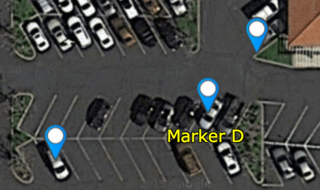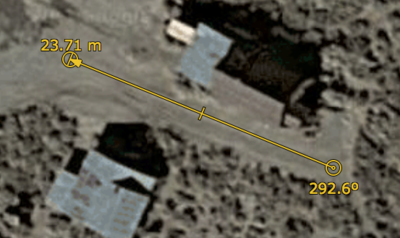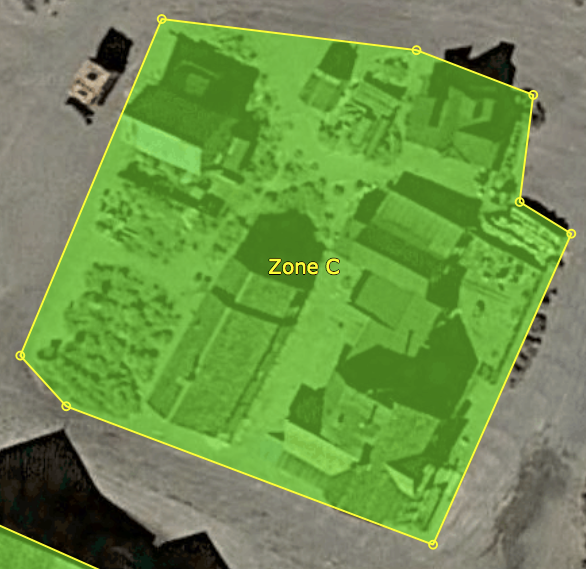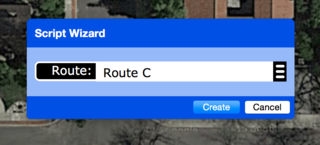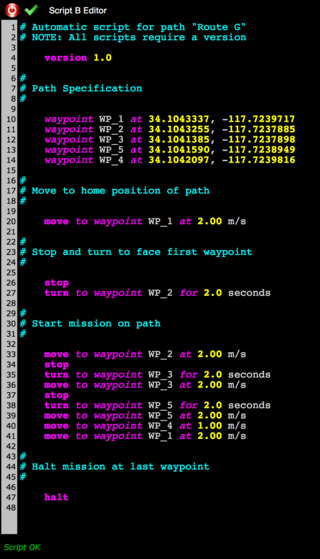Difference between revisions of "Hydra"
Nltwikiadmin (talk | contribs) (Added zone creation notes) |
Nltwikiadmin (talk | contribs) m (→No-fly Zones) |
||
| Line 136: | Line 136: | ||
[[File:NoFly_Zone.png|640px]] | [[File:NoFly_Zone.png|640px]] | ||
| + | |||
| + | Zones can be convex as well as concave and must have a minimum of 3 vertices.<br /> | ||
| + | Zones cannot have holes or intersect itself.<br /> | ||
| + | |||
=== Creating a no-fly zone === | === Creating a no-fly zone === | ||
Revision as of 03:50, 12 June 2017
Contents
- 1 Introduction
- 2 Components of a mission
- 3 Creating a new mission
- 4 About the Tool Pallet
- 5 Map modification Tools
- 6 Markers
- 7 Rulers
- 8 No-fly Zones
- 9 Routes
- 10 Scripts
- 11 Simulators
- 12 Robot & Simulator Operation
- 13 Robot telemetry
- 14 Scenario Operation
- 15 Mission Planner Settings
- 16 Equipment Settings
- 17 Setting up the wifi network
Introduction
Components of a mission
The map
The map is the birds-eye view of the operational arena in which the robot is operating. → Usage
Markers
Markers are graphic indicators for locations of interest.
These include home locations of robots and the antenna location of the base station. → Usage
Routes
Routes are paths used by the robot to travel from waypoint to waypoint. → Usage
Scripts
One of the more powerful features of planning a mission is using a script to describe a unique motion per robot.
While routes give you basic motion from A to B with a specific speed, script allows you to stop, turn,
and vary the speed from waypoint to waypoint based on timing. → Usage
No-fly zones
No-fly zones are areas where the robot are not allowed to travel to or through.
These include obstructions such as buildings and difficult terrains to traverse.→ Usage
Rulers
This feature allows you to measure distances and orientation angle relative to true north. → Usage
About Mission files
Creating a new mission
From Lat/Long
Address lookup
From a GPS unit
About the Tool Pallet
Tool tips
Drawing element visibility
Special Tool Functions
Creating a simulator
Creating a script
Map modification Tools
Map parameter editing
Robot shifting
Map shifting
Markers
Markers are used to indicate points of interest in the arena.
They also indicate special locations such as the base station's GPS antenna and home location for a robot to return to.
Markers are indicated by ![]() in the arena view and selecting a marker will show its name.
in the arena view and selecting a marker will show its name.
A special marker indicated by ![]() shows the location of the home position of a robot.
shows the location of the home position of a robot.
The optional GPS antenna location is shown with this ![]() graphic indication.
graphic indication.
Creating a marker
To add a marker, select the create marker icon ![]() in the tool palette.
in the tool palette.
Click on the arena map to place the new marker. The bottom tip will be the exact location.
Editing a marker
To move a marker, select the edit marker icon ![]() in the tool palette.
in the tool palette.
Click on the marker and move it to a new location.
Renaming
Marker's name can be renamed by selecting the name in the element view to the right of the map view.
Removing
To delete a marker, click on the marker's delete button in the element list view.
Optional Base Station Marker
To indicate the base station's GPS antenna location, use the GPS icon ![]() from the
maker tool palette. Only one antenna location is allowed.
from the
maker tool palette. Only one antenna location is allowed.
Click on the map to create it, or click on the existing marker to move it.
Rulers
Creating a ruler
Click on the ruler icon ![]() to add a new distance ruler to the map.
to add a new distance ruler to the map.
In the arena view, click on the starting point of the measurement and drag the destination point.
The distance and orientation will be displayed in real time while the ruler is created.
Once the ruler is added, it will display its length in a fine print when unselected.
When selected, both distance and orientation are displayed.
Editing a ruler
Click on the ruler edit icon ![]() to edit an existing ruler.
to edit an existing ruler.
Click on either end to reposition it, or click on the line connection the two ends to move the whole ruler.
Renaming
A ruler's can be renamed by selecting the name in the element list view to the right of the map view.
Removing
Click on the ruler's delete button in the element list view to the right of the map view.
No-fly Zones
Zones can be convex as well as concave and must have a minimum of 3 vertices.
Zones cannot have holes or intersect itself.
Creating a no-fly zone
Creating a no-fly zone can be done with a variety of shape tools.
Zones can be convex as well as concave and must have a minimum of 3 vertices.
It cannot have holes.
![]() creates a zone aligned along north-south and east-west.
creates a zone aligned along north-south and east-west.
![]() creates a rectangle using the third point to rotate it to an arbitrary direction.
creates a rectangle using the third point to rotate it to an arbitrary direction.
![]() creates a circular zone anchored at the first point and using the second point to specify the diameter.
creates a circular zone anchored at the first point and using the second point to specify the diameter.
![]() creates a circular zone using 3 points.
creates a circular zone using 3 points.
![]() Create a free-form zone with as many points as necessary to fit the area.
Create a free-form zone with as many points as necessary to fit the area.
The first click establishes the first vertex.
While dragging around the mouse for the second click, the potential side of the zone is displayed in real time before setting down the next vertex.
Each subsequent click will add another vertex until the first vertex is clicked, closing the zone and terminating the current zone creation.
At any time, the user may hit the return key to automatically close the zone and terminate the operation.
Hitting the delete/backspace key while in zone creation will remove the last vertex.
Arena Boundary Zone
Editing a no-fly zone
Renaming
Removing
Routes
Elements of a route
Waypoints
Legs
Creating a route
Route options
Closed Loop
Smooth Path
Visual Aids
Route Length
Confidence
Sharp turn indication
Editing route elements
Inserting waypoints
Translating a route
Duplicating a route
Additional information
Renaming
Deleting
Locking
Fixing
Scripts
A typical script is structured like this:
# Automatic script for path "Route G"
# NOTE: All scripts require a version
version 1.0
#
# Path Specification
#
waypoint WP_1 at 34.1043337, -117.7239717
waypoint WP_2 at 34.1043255, -117.7237885
waypoint WP_3 at 34.1041385, -117.7237898
waypoint WP_5 at 34.1041590, -117.7238949
waypoint WP_4 at 34.1042097, -117.7239816
#
# Move to home position of path
#
move to waypoint WP_1 at 2.00 m/s
#
# Stop and turn to face first waypoint
#
stop
turn to waypoint WP_2 for 2.0 seconds
#
# Start mission on path
#
move to waypoint WP_2 at 2.00 m/s
stop
turn to waypoint WP_3 for 2.0 seconds
move to waypoint WP_3 at 2.00 m/s
stop
turn to waypoint WP_5 for 2.0 seconds
move to waypoint WP_5 at 2.00 m/s
move to waypoint WP_4 at 1.00 m/s
move to waypoint WP_1 at 2.00 m/s
#
# Halt mission at last waypoint
#
halt
A script consists of both executable and non-executable lines.
Non-executable lines are either comments that you can use to document or empty lines.
A comment line always starts with # (pound sign) followed by an optional line of text.
Empty lines are typically used for formatting purposes to easier read the script.
Executable lines have a single command with options that perform some kind of action.
Only one command per line is allowed.
Every command is terminated by a carriage return.
Command Set
| Command | Description | Usage |
|---|---|---|
| version | This is required as the first executable.
It indicates the version of the script for proper execution. |
version < float >
|
| waypoint | This command specifies a named waypoint.
Waypoints are destinations on the map as latitude, longitude. |
waypoint < name > at < longitude >,< latitude >
|
| stop | Stop the robot with optional time until next command is executed. | stop
stop for < time > seconds
|
| halt | Stop the robot and terminate the script. | |
| turn | Turn the robot by either an angle or towards a waypoint. | turn < angle > for < time > seconds >
turn to waypoint < name > for < float > seconds
|
| move | Drive the robot at the specified speed towards its destination | move at < speed > m/s for < time > s
move to waypoint < name > at < speed > m/s
move to location < longitude >, < latitude > at < speed > m/s
move to < name > at < speed > m/s
|
Creating a Script
Scripts are created by double clicking the script tool.
You will be asked to specify an existing route or a blank script.
If no route is specified, a simple blank script is created without any commands.
If a route is specified, a fully functional script with the route's waypoints and appropriate commands to traverse the route.
This is the easiest way to create functional script.
Once the creation dialog is dismissed, the new script will appear in the script list.
You may change the name of the script in the script list by simply clicking on the name and editing it.
Editing a Script
Click on the edit icon ![]() to edit the script in the editor.
The editor pane is divided into three parts.
to edit the script in the editor.
The editor pane is divided into three parts.
The top line indicates the name of the script and shows the syntax check and close button.
The bottom line shows important messages.
Finally the middle part is the editor itself displaying the script for modification.
Each line of the script is numbered to the left of the script text.
This is useful in fixing syntax errors.
The editor uses color to tag correct syntax.
Any text that is gray indicates either a syntax error or optional words not necessary for the execution.
Cyan (bluish) lines are comments.
Purple words are commands and required keywords.
Yellow are numbers.
Click the check mark ![]() on the top line to verify the syntax of the script.
on the top line to verify the syntax of the script.
if the script is correct, the message "Script OK" will appear in the message line.
if the syntax is not correct, the message will indicate the line number and syntax problem followed by "Script Error" below.
To close the editor, click the close button ![]() .
.
Waypoints locations may be edited using the editor or, better yet, graphically on the map.
Each script is shown as a blue route.
Clicking on the waypoint of a script route and moving it will modify the script to record the new waypoint location.
The script is then automatically saved.
Timing Graph
Timing are edited using the timeline editor on the bottom of the main interface.
To show the timing graph, click on the timing edit icon ![]() of the script element.
of the script element.
The timing graph shows the script's timeline in a graphical way.
The horizontal dimension shows the time starting at zero while the vertical dimension represents the speed in meters per second.
The yellow line represents the speed of the robot in time.
The blue areas shows motion along waypoints at speed indicated by the yellow graph.
The green areas are rest time intervals where the robot is either stopping or turning.
The gray lines separating the rest and motion time intervals can be selected and dragged horizontally to change the time interval of the prior area.
These changes will be indicated in the script and automatically saved.
While changing the time interval of a motion (blue) region, you will notice that the script will correspond by changing the speed.
Increasing the time interval will drop the speed (slow down).
Decreasing the time interval will raise the speed (speed up). This is due to basic physics. While the motion distance stays the same,
the robot has to travel faster if the time to traverse is less. Otherwise, it has to slow down when the time to reach the end of that section is increased.
The speed of the robot can be manipulated as well by selecting the speed graph (yellow line) and modified by moving up or down.
When changing the speed, you will notice that the time interval is modified as well.
Timing is adjusted as the speed is changed since the distance traveled stays the same.
Simulating a script
Simulating a script is the same as simulating a robot.
Startup a robot simulation and set the robot's mission to the script.
Execute the robot's mission.
Simulators
Creating a simulator
Robot & Simulator Operation
Device Status Display
Device name
Mission assignment
Heartbeat indicator
Battery indicator
RF Link quality indicator
INS Status
Device Track Display
RF Signal Mode
GPS Mode
Assigning the mission
Operational Controls
Play/Pause
Stop
Playback direction
Repeat/Oscillate
Go to beginning
Go to end
Line Up
Go to Home
Manual
Robot telemetry
Master Alarm
Scenario Operation
Heading text
Joystick-controlled Playback Speed
Mission Planner Settings
Distance Units
Max Track Samples
Track sample spacing
Telemetry samples
Local GPS unit
Equipment Settings
Setting up the wifi network
Connecting via ethernet
- Plug in ethernet cable
- Set PC to manual IP address 192.168.0.51 mask 255.255.255.0
- Open browser to 192.168.0.50
- Go to Dashboard. Click Stop wlan0.
- Click Refresh. Make sure that it says “Interface is down”
- Go to System. Click Restart Robot.
- Launch Mission Planner.
- Perform firmware upgrade.
- Verify that new firmware is running.
- Quit Mission Planner
- Open browser to 192.168.0.50
- Go to Dashboard. Click Start wlan0.
- Disconnect ethernet cable.
- Open browser to robot name e.g. Hydra-170401-1.local
- Go to System. Click Restart Robot.
- Launch Mission Planner.
- Verify connectivity.
